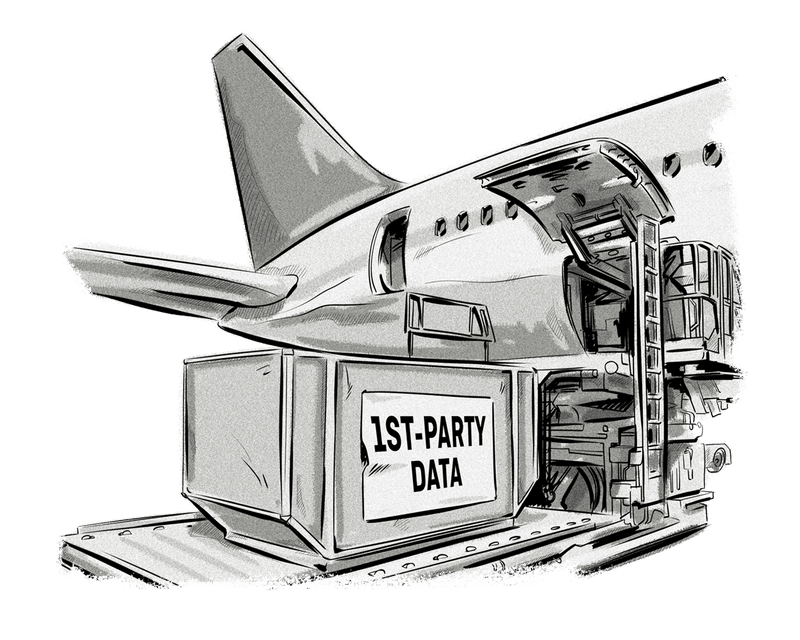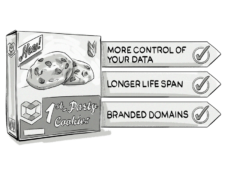At the heart of every marketing and advertising campaign is data, and in the online world, there are truckloads of it, with even more set to arrive in the coming years thanks to the growth of the Internet of Things (IoT).
This enormous amount of information allows marketers and advertisers to better identify their target audience and display relevant ads at the right time; but not all data is created equal, and some sources are considered more valuable than others. In this industry, first-party data is the cream of the crop.
What is First-Party Data?
First-party data is essentially any piece of data collected directly from a customer, both offline and online.
Let’s use a telecommunications company as an example and take a look at the different types of offline first-party data and online first-party data.
In the offline world, an example of first-party data would be the customer’s account information, such as a name and an address.
In the online world, first-party data would be data collected via the company’s web-analytics tools – e.g. if the customer visited the telecommunications company’s website.
In years past, there was a big focus on acquiring and integrating third-party data with a company’s first-party data. While the third-party data wasn’t as valuable as the first-party information, it enabled companies to identify customer behaviors and trends, and helped them get their message in front of more people.
However, marketers and advertisers are now finding that even with these improvements, the real payoff is found in first-party data, which, according to a recent study from Econsultancy and Signal, the use of for advertising is set to rise due to the value it brings to a company.

The increasing value of first-party data is the driving force behind the first-party onboarding movement.
What is First-Party Data Onboarding?
In the simplest terms, first-party data onboarding is the process of taking your offline customer information and integrating it with your online customer profile.
So, for example, a company could have the following customer data in their offline database:
- Name
- Residential addresses
- Phone numbers
- Email addresses
- Date of birth
- And all other data they have about customers in their offline Customer Relationship Management (CRM) systems, such as transactional information
They could then onboard it with the data they have in their online databases, such as:
- Data from their web-analytics tools and ad servers
- User account information (e.g. account information from the company’s online payment system)
- Any other online information the company has collected about the customer, including the same information they’ve collected offline – e.g. name, email, and residential address
However, in order to effectively and safely integrate their offline data with online data, they have to use an onboarding platform.
Here’s a list of some of the most common data-onboarding platforms on the market:

How Does First-Party Data Onboarding Work?
While each data-onboarding process will vary somewhat from platform to platform, the basic principle is the same:
- Companies upload their offline first-party data to the onboarding platform.
- Then, through an anonymization process (e.g. hashing, encryption, or generalization), the onboarding platform transforms the data to remove any Personally Identifiable Information (PII), such as the customer’s email, name, address, and date of birth.
- The offline data is then matched with the online data with the help of identifiers. For example, if a company has collected a customer’s email both offline and online, the onboarding platform would match the two sources of data via the common email address.
Typically, during the data onboarding process, companies will also receive additional data like user IDs and cookie IDs, which they can then match with their online data (e.g. from their web-analytics tools).
The cookie IDs come from third-party demand-side platforms (DSP), and can be used for creating audiences, which will then be used for ad targeting.

Data Onboarding With Google AdWords, Facebook Ads, and AdRoll
The data-onboarding process offered by companies like LiveRamp, neustar, iBehavior, etc., often involves large amounts of data, as typically they onboard the information from a company’s data-management platform (DMP). This means the process is quite complex and can often take days to complete.
However, there are a few tools that offer a simpler onboarding process to help companies use their offline data to target customers online.
Google AdWords
Through Google’s new product Customer Match, companies and brands can upload their customer email list to AdWords and target those customers and related audiences across Google’s wide product range, including Google Search, YouTube, and Gmail.
Facebook Ads
Similar to Google’s Customer Match, Facebook’s new Custom Audiences allows companies and brands to not only upload customer email lists to Facebook Ads for targeting on the Facebook platform, but to also place a tracking pixel on their website and/or app. Once placed, the pixel will track that user and then display a customized ad or offer to that user on Facebook.
AdRoll
AdRoll’s core service is retargeting, which includes retargeting on Facebook, Twitter, across the web, and on mobile. The tool also provides a CRM data-onboarding service, whereby companies and brands are able to onboard their offline and online customer data to use for retargeting across the aforementioned channels.
One of the main benefits of using the tools listed above is they don’t require companies to have a DMP, which means that even small businesses can utilize this simpler onboarding process and target their audience across a range of channels and devices.







